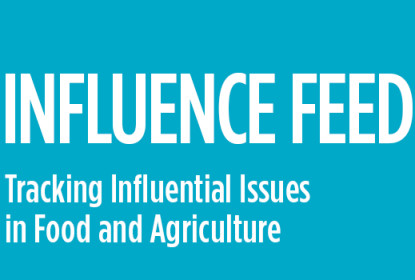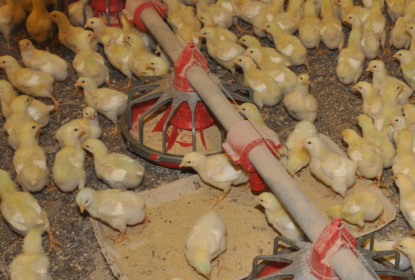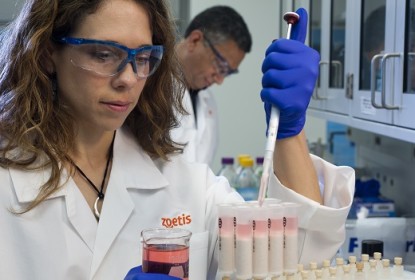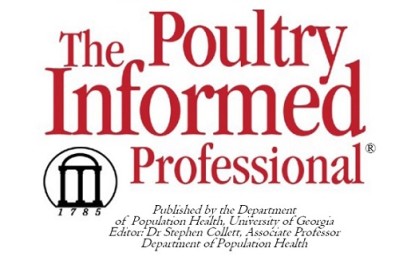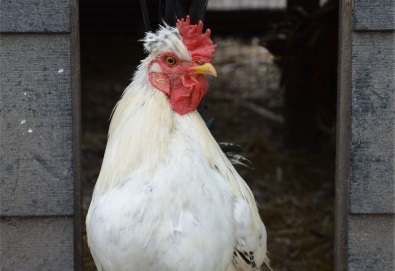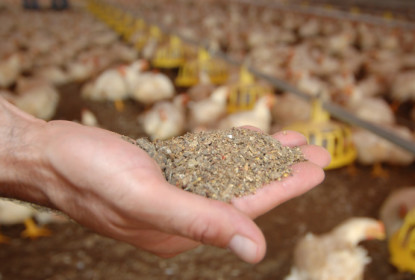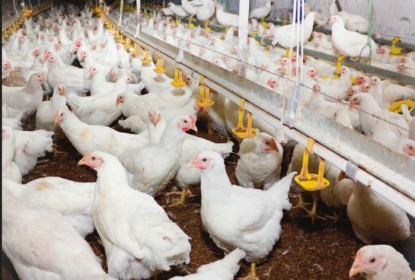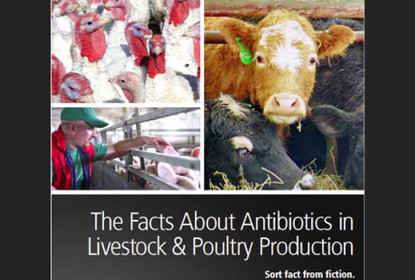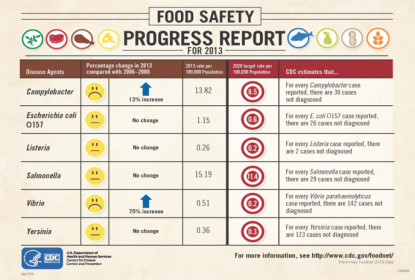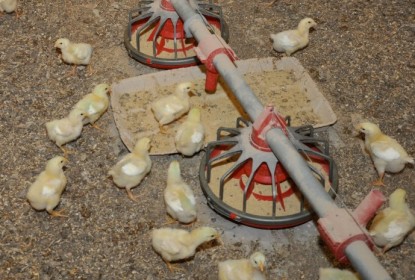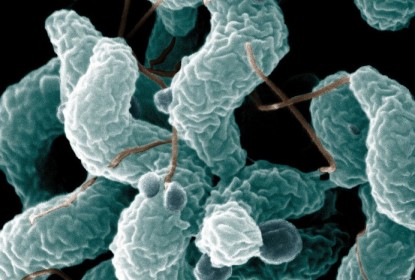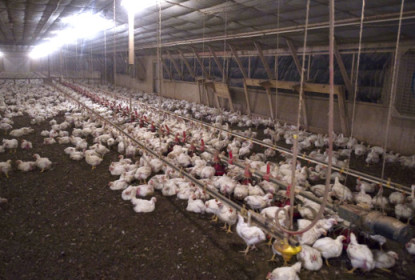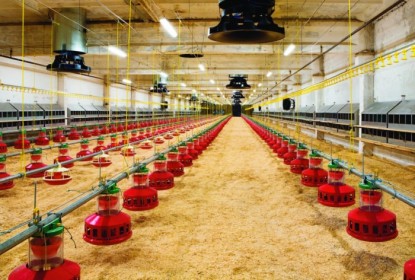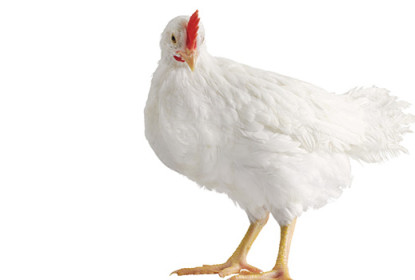Author Archive: Jennifer Grullon
... New antibiotic initiatives spark more debate in Washington
Sep 30, 2014Jennifer GrullonComments Off on New antibiotic initiatives spark more debate in Washington
The President's Council of Advisors on Science and Technology released a report Sept. 18 on combating antibiotic resistance, which accompanied the president's executive order to create a government...... Layers 2013 Part 1: Reference of health and management practices on table-egg farms in the United States, 2013
Sep 29, 2014Jennifer GrullonComments Off on Layers 2013 Part 1: Reference of health and management practices on table-egg farms in the United States, 2013
An overview of egg flock management in the US, based on a detailed survey of 328 farms with at least 3,000 birds across 19 states by the USDA Animal and Plant Health Inspection Service (APHIS). The...... USDA announces new inspection system for poultry products
Sep 26, 2014Jennifer GrullonComments Off on USDA announces new inspection system for poultry products
The US Department of Agriculture's (USDA) Food Safety and Inspection Service (FSIS) last week announced a critical step forward in making chicken and turkey products safer for Americans to eat.... USDA announces new inspection system for poultry products
Sep 26, 2014Jennifer GrullonComments Off on USDA announces new inspection system for poultry products
The US Department of Agriculture's (USDA) Food Safety and Inspection Service (FSIS) last week announced a critical step forward in making chicken and turkey products safer for Americans to eat.... Kinky back takes costly toll on broilers at 4 to 6 weeks
Sep 24, 2014Jennifer GrullonComments Off on Kinky back takes costly toll on broilers at 4 to 6 weeks
Broiler producers are being urged to watch for signs of kinky back, an emerging bacterial disease of poultry that can cause significant losses in birds 4 to 6 weeks of age.... Campylobacter research reveals potential for poultry vaccine
Sep 19, 2014Jennifer GrullonComments Off on Campylobacter research reveals potential for poultry vaccine
Researchers at the USDA Richard B. Russell Agricultural Research Center have purified proteins from Campylobacter and tested them for their potential use as vaccines.... Poultry disease prevention checklist
Sep 15, 2014Jennifer GrullonComments Off on Poultry disease prevention checklist
Dr Casey Ritz of the University of Georgia presents a checklist for poultry farmers to assess the biosecurity risk on their farm.... Five reasons for the poultry industry not to be transparent
Sep 12, 2014Jennifer GrullonComments Off on Five reasons for the poultry industry not to be transparent
What are the top reasons the poultry industry isn’t transparent with the public? Todd Simmons, CEO and vice chair, Simmons Foods, named five in a speech at the Arkansas Nutrition Conference, but he...... Coccidiosis specialist: ‘Understand’ the products you’re using
Sep 11, 2014Jennifer GrullonComments Off on Coccidiosis specialist: ‘Understand’ the products you’re using
Coccidiosis has been around as long as any poultry producer can remember. And despite decades of experience with the tenacious parasitic disease, it hasn’t gotten any easier to manage. In fact,...... Researchers find potential link between feeding DDGS and necrotic enteritis in broilers
Sep 09, 2014Jennifer GrullonComments Off on Researchers find potential link between feeding DDGS and necrotic enteritis in broilers
High levels of DDGS (15%) were found in studies at Auburn University to amplify mild to moderate cases of necrotic enteritis into more severe cases.... Author of California bill defends using antibiotics to prevent disease
Aug 28, 2014Jennifer GrullonComments Off on Author of California bill defends using antibiotics to prevent disease
California lawmakers passed SB-835 (Food animals: medically important antimicrobial drugs), which mirrors the U.S. Food and Drug Administration's Guidance 213 (covered in Influence Feed edition "Real...... Zoetis receives full license for Georgia 08 IB vaccine
Aug 27, 2014Jennifer GrullonComments Off on Zoetis receives full license for Georgia 08 IB vaccine
Zoetis Inc. has obtained a full license from the USDA to sell Poulvac® Bron GA 08, the first commercially available vaccine to reduce disease caused by Georgia 2008 (GA 08) Type infectious...... Activist groups defeated in attempts to curb antibiotic use
Aug 13, 2014Jennifer GrullonComments Off on Activist groups defeated in attempts to curb antibiotic use
Two activist efforts recently suffered defeats in attempts to curb antibiotic use in US animal agriculture... Avian Mycoplasma diagnostics
Aug 04, 2014Jennifer GrullonComments Off on Avian Mycoplasma diagnostics
By Naola Ferguson-Noel, Poultry Diagnostic and Research Center, Department of Population Health, University of Georgia, Athens, GA... Control of avian mycoplasmosis
Aug 04, 2014Jennifer GrullonComments Off on Control of avian mycoplasmosis
By Naola Ferguson-Noel, Poultry Diagnostic and Research Center, Department of Population Health, University of Georgia, Athens, GA... PCR: A simple explanation
Aug 04, 2014Jennifer GrullonComments Off on PCR: A simple explanation
By Mark Jackwood, Poultry Diagnostic and Research Center, Department of Population Health, University of Georgia, Athens, GA... Temperature of drinking water may affect bodyweight during brooding
Jul 19, 2014Jennifer GrullonComments Off on Temperature of drinking water may affect bodyweight during brooding
The temperature of drinking water during brooding may affect the bodyweight of broiler chicks, according to a University of Arkansas study.... S. enteritidis frequency in eggs similar in conventional and enriched cage systems
Jul 19, 2014Jennifer GrullonComments Off on S. enteritidis frequency in eggs similar in conventional and enriched cage systems
The frequency of egg contamination with S. enteritidis did not significantly differ between hens housed in conventional and enriched cages, investigators say in the March 2014 issue of Poultry...... Cracked corn has positive effect in broilers
Jul 19, 2014Jennifer GrullonComments Off on Cracked corn has positive effect in broilers
Cracked corn fed to broilers increased weight gain and gizzard size and had a positive effect on gut microflora, say New Zealand investigators.... Making sense of poultry labels
Jul 19, 2014Jennifer GrullonComments Off on Making sense of poultry labels
Demand for increased transparency has led to the proliferation of poultry labeling terms — many of which surface in discussions about sustainability and production practices. What these terms...... Timing may affect accuracy of in ovo vaccination
Jul 19, 2014Jennifer GrullonComments Off on Timing may affect accuracy of in ovo vaccination
The coccidiosis vaccine Inovocox® EM1 was more precisely deposited to embryos when the vaccine was administered at 18.5 versus 19 days of incubation, indicates a Zoetis-sponsored study from...... Editorial: Never say never
Jul 19, 2014Jennifer GrullonComments Off on Editorial: Never say never
Not that long ago, the thought of raising broilers on a large scale without ionophores or other intestinal health antibiotics would have seemed foolhardy. But that has changed in recent years, as...... Sustainability tops list of poultry topics during first half of 2014
Jul 18, 2014Jennifer GrullonComments Off on Sustainability tops list of poultry topics during first half of 2014
Sustainability was the most highly discussed topic in the US poultry industry during the first half of 2014, according to an analysis by Influence Feed.... Get the most from your ELISA tests
Jul 15, 2014Jennifer GrullonComments Off on Get the most from your ELISA tests
Andrea Zedek, a veterinarian at Zoetis Inc., offers tips for ensuring accuracy when using ELISA tests to diagnose a poultry flock's health status.... New FDA antibiotic guidelines: What’s a VFD?
Jul 04, 2014Jennifer GrullonComments Off on New FDA antibiotic guidelines: What’s a VFD?
The phrase Veterinary Feed Directive (VFD) may be new to poultry veterinarians and producers, but the process has actually been around since 1996, when Congress passed the Animal Drug Availability...... #152 Guidance for Industry: Evaluating the safety of antimicrobial new animal drugs with regard to their microbiological effects on bacteria of human health concern
Jul 03, 2014Jennifer GrullonComments Off on #152 Guidance for Industry: Evaluating the safety of antimicrobial new animal drugs with regard to their microbiological effects on bacteria of human health concern
Appendix A of this document ranks antimicrobial drugs according to their importance in human medicine and may be updated by FDA.... New FDA antibiotic guidelines: Why comply?
Jul 02, 2014Jennifer GrullonComments Off on New FDA antibiotic guidelines: Why comply?
FDA’s new antimicrobial guidelines are strictly voluntary — to a degree. In the agency’s own words, they “do not establish legally enforceable responsibilities”; they merely “describe the...... Feeling misunderstood? Vet urges producers to take action
Jul 01, 2014Jennifer GrullonComments Off on Feeling misunderstood? Vet urges producers to take action
Don’t blame consumers if they seem to have little understanding of modern poultry and livestock production. “It’s not their fault and it is not intentional. It is just the way society has...... Should antibiotics be used to prevent disease in poultry?
Jun 19, 2014Jennifer GrullonComments Off on Should antibiotics be used to prevent disease in poultry?
Three veterinarians explain why they think it's a sensible and ethical thing to do with certain diseases.... Should antibiotics be used to prevent disease in poultry?
Jun 19, 2014Jennifer GrullonComments Off on Should antibiotics be used to prevent disease in poultry?
Using antibiotics to prevent — not just treat or control — certain diseases of poultry is a sensible, responsible and ethical practice, according to three veterinarians featured on an industry...... Coccidiosis: Why is it still so difficult to control?
Jun 12, 2014Jennifer GrullonComments Off on Coccidiosis: Why is it still so difficult to control?
Coccidiosis can be extremely difficult to manage in poultry because the organism that causes it "has a tremendous capability to reproduce and it's very resistant to any kind of attempt to destroy...... ‘Organic’ labels for poultry, other foods challenged in recent news reports
Jun 09, 2014Jennifer GrullonComments Off on ‘Organic’ labels for poultry, other foods challenged in recent news reports
Critics of the organic labels for poultry meat and other foods are speaking up, reports the latest edition of Influence Feed.... Intestinal health and necrotic enteritis in broilers
Jun 03, 2014Jennifer GrullonComments Off on Intestinal health and necrotic enteritis in broilers
Management at the farm level (litter quality and composition, lighting programmes, stocking density, drinker management and dietary feed management) are important to control necrotic enteritis,...... Reality check: Oft-cited antibiotic-usage figure mixes numbers from two reports
Jun 03, 2014Jennifer GrullonComments Off on Reality check: Oft-cited antibiotic-usage figure mixes numbers from two reports
Confidently presenting facts — not defensive rhetoric — can go a long way toward shaping consumer opinions about commercial poultry production and the importance of maintaining flock health,...... Reality check: 87% of antibiotics used in animals rarely used in human medicine
Jun 02, 2014Jennifer GrullonComments Off on Reality check: 87% of antibiotics used in animals rarely used in human medicine
Confidently presenting facts — not defensive rhetoric — can go a long way toward shaping consumer opinions about commercial poultry production and the importance of maintaining flock health,...... Reality check: Multidrug-resistant strains of Salmonella rare in humans
Jun 01, 2014Jennifer GrullonComments Off on Reality check: Multidrug-resistant strains of Salmonella rare in humans
Confidently presenting facts — not defensive rhetoric — can go a long way toward shaping consumer opinions about commercial poultry production and the importance of maintaining flock health,...... Antibiotic resistance revisited in recent media reports
May 27, 2014Jennifer GrullonComments Off on Antibiotic resistance revisited in recent media reports
Following the April 2014 World Health Organization (WHO) report warning of a “post-antibiotic era,” Current Biology published the findings of a new study on May 19, reports Influence Feed.... New studies examine effects of lighting on chickens
May 17, 2014Jennifer GrullonComments Off on New studies examine effects of lighting on chickens
Two recent studies show that broilers perform better under LED lighting than fluorescent lamps while layer behaviour is affected by light wavelength.... CDC releases progress report on food safety
Apr 28, 2014Jennifer GrullonComments Off on CDC releases progress report on food safety
The US Centers for Disease Control and Prevention (CDC) released a Foodborne Diseases Active Surveillance Network (FoodNet) report last week indicating that rates of Salmonella recently declined...... Supplemental bacitracin reduces mortality, C. perfringens in broilers
Apr 17, 2014Jennifer GrullonComments Off on Supplemental bacitracin reduces mortality, C. perfringens in broilers
Commercial broilers that received a bacitracin-supplemented diet had less Clostridium perfringens in their gut, according to researchers at Ohio State University.... Getting the best results from veterinary histopathology*
Apr 17, 2014Jennifer GrullonComments Off on Getting the best results from veterinary histopathology*
by Susan Williams, DVM, PhD, ACPV Poultry Diagnostic and Research Center, College of Veterinary Medicine, University of Georgia, Athens, GA... Editorial: ‘To health!’
Apr 17, 2014Jennifer GrullonComments Off on Editorial: ‘To health!’
Welcome to Poultry Health Today, a new magazine we’re sponsoring to keep US producers, veterinarians and nutritionists on top of the latest developments in this critical area of production.... Impact of lighting types on broiler performance
Apr 17, 2014Jennifer GrullonComments Off on Impact of lighting types on broiler performance
A study at the University of Delaware shows that broiler performance in terms of breast and body weights was similar for two poultry-specific LED lamps and incandescent lamps and better than for... FDA issues update on antibiotic guidelines
Apr 13, 2014Jennifer GrullonComments Off on FDA issues update on antibiotic guidelines
The U.S. Food and Drug Administration (FDA) issued on March 26 an Update on Animal Pharmaceutical Industry Response to Guidance #213, which asked animal health companies to voluntarily phase out...... Remembering (and channeling) Dr. Scott Hurd
Apr 11, 2014Jennifer GrullonComments Off on Remembering (and channeling) Dr. Scott Hurd
The last time we talked with Iowa State University’s Dr. Scott Hurd, he was joyfully, if not playfully, musing about all the topics he could cover in his new blog for Poultry Health Today....... ‘Socially responsible’ food production stirs debate
Mar 31, 2014Jennifer GrullonComments Off on ‘Socially responsible’ food production stirs debate
The past few weeks have showcased the exploration of "socially responsible" food production and its consumer appeal, occasionally with contradictory findings, according to the latest edition of...... Experimental and applied approaches to control Salmonella in broiler processing
Mar 17, 2014Jennifer GrullonComments Off on Experimental and applied approaches to control Salmonella in broiler processing
By Dr. Mark E. Berrang USDA—Agricultural Research Service, Russell Research Center, Athens, GA... ‘Influence Feed’ now featured on Poultry Health Today
Mar 13, 2014Jennifer GrullonComments Off on ‘Influence Feed’ now featured on Poultry Health Today
Poultry Health Today is pleased to feature Influence Feed — a biweekly report rounding up the hot topics in food and agriculture, as determined by the most influential voices from across the...... Numbers, figures and the fine print
Mar 11, 2014Jennifer GrullonComments Off on Numbers, figures and the fine print
Between announcing the federal government’s first major updates to the Nutrition Facts panel in 20 years and the restriction of in-school advertising of foods that don’t meet healthy guidelines,...... Poultry veterinarian shares ideas for managing coccidiosis more effectively, economically, sustainably
Feb 28, 2014Jennifer GrullonComments Off on Poultry veterinarian shares ideas for managing coccidiosis more effectively, economically, sustainably
Don Waldrip, DVM, talks about a new a new science-based, global initiative from Zoetis to help poultry producers develop longer term, sustainable management of coccidiosis.... Incentives missing in New Poultry Inspection System, says NCC’s Peterson
Feb 26, 2014Jennifer GrullonComments Off on Incentives missing in New Poultry Inspection System, says NCC’s Peterson
The ability to forgo the SIP waiver process for on-line processing may be the rule’s biggest benefit for the poultry industry, said the National Chicken Council’s Vice President of Science and...... Defining wholesomeness
Feb 25, 2014Jennifer GrullonComments Off on Defining wholesomeness
The past two weeks have featured the convergence of special interest agendas and consumer food trends into a series of high-profile business developments. In particular, Chick-fil-A’s announcement...... Five federal bills seek to curb on-farm antibiotic use
Feb 13, 2014Jennifer GrullonComments Off on Five federal bills seek to curb on-farm antibiotic use
Although FDA has introduced new guidelines for using feed antibiotics in poultry and livestock, some members of Congress would like the industry to go a few steps further.... Transparency or exaggeration?
Feb 11, 2014Jennifer GrullonComments Off on Transparency or exaggeration?
In the past weeks we’ve taken note of two prominent foodservice companies using agricultural practices for marketing positioning. McDonald’s and Chipotle instigated influencer conversation by...... Welcome to Influence Feed
Jan 28, 2014Jennifer GrullonComments Off on Welcome to Influence Feed
Welcome to the Food and Agriculture Influence Feed from Zoetis, a biweekly report rounding up the top topics in food and agriculture, as determined by the most influential voices from across the...... CDC: Widespread use of antibiotics in hospitals is leading cause of resistance
Jan 24, 2014Jennifer GrullonComments Off on CDC: Widespread use of antibiotics in hospitals is leading cause of resistance
The most important cause of antibiotic-resistant infections in people can be attributed to widespread antibiotic use in hospitals, according to the Centers for Disease Control and Prevention (CDC).... Rotecc™ coccidiosis management video
Jan 24, 2014Jennifer GrullonComments Off on Rotecc™ coccidiosis management video
Learn more about the new global coccidiosis-management initiative from Zoetis.... Antibiotic resistance threats in the United States, 2013
Jan 22, 2014Jennifer GrullonComments Off on Antibiotic resistance threats in the United States, 2013
This CDC report explores antimicrobial resistance, one of our most serious health threats. Efforts to prevent such threats build on the foundation of proven public health strategies: immunization,...... Specialists discuss impact of new FDA guidelines
Jan 22, 2014Jennifer GrullonComments Off on Specialists discuss impact of new FDA guidelines
In anticipation of the new FDA guidelines for antibiotic usage, Zoetis, Inc., teamed with Watt Global Media to organize a panel discussion about the future of antibiotics in poultry. Following are...... Veterinarians define judicious antibiotic use in poultry
Jan 21, 2014Jennifer GrullonComments Off on Veterinarians define judicious antibiotic use in poultry
With antibiotics, deciding when to use them is as essential as determining how much.... Using antibiotics to improve flock performance
Jan 21, 2014Jennifer GrullonComments Off on Using antibiotics to improve flock performance
Low doses of some antibiotics can help maintain a healthy flock without increasing drug resistance, according to a University of Minnesota veterinarian.... #209 Guidance for Industry: The judicious use of medically important antimicrobial drugs in food-producing animals.
Jan 15, 2014Jennifer GrullonComments Off on #209 Guidance for Industry: The judicious use of medically important antimicrobial drugs in food-producing animals.
GFI 209 presents the FDA’s recent thinking on the topic and lays out FDA strategy and recommendations.... Methods of diagnosing enteric disease clarified
Jan 15, 2014Jennifer GrullonComments Off on Methods of diagnosing enteric disease clarified
Diagnosing clostridial enteric disease in poultry remains a challenge — primarily because many clostridial species can be a normal inhabitant of the gut, which makes it difficult to determine their...... Increased CVI988 vaccine use credited with decline in Marek’s disease
Jan 15, 2014Jennifer GrullonComments Off on Increased CVI988 vaccine use credited with decline in Marek’s disease
Increased use of CVI988/Rispens vaccines is credited with declines in the incidence of Marek’s disease (MD), according to investigators from USDA‘s Agricultural Research Service.... Single dose of Poulvac IBMM+Ark protects long-lived broilers for at least 9 weeks
Jan 15, 2014Jennifer GrullonComments Off on Single dose of Poulvac IBMM+Ark protects long-lived broilers for at least 9 weeks
One dose of the live, attenuated vaccine Poulvac® IBMM+Ark effectively protected broilers against two infectious bronchitis (IB) strains for at least 9 weeks, a recent study shows.... Better protection shown with recommended Marek’s disease vaccine dose in two genetic lines
Jan 15, 2014Jennifer GrullonComments Off on Better protection shown with recommended Marek’s disease vaccine dose in two genetic lines
The recommended dose of two Marek’s disease virus (MDV) vaccines provided better protection in two genetic lines of meat-type chickens compared to a lower dose, the results of a recent study show,...... Organic raw poultry not necessarily safer
Jan 15, 2014Jennifer GrullonComments Off on Organic raw poultry not necessarily safer
Organic raw poultry is not necessarily safer for consumption than conventionally raised poultry, indicates a study from the University of Tennessee.... New studies examine effects of lighting on chickens
Jan 14, 2014Jennifer GrullonComments Off on New studies examine effects of lighting on chickens
Two recent studies show that broilers perform better under LED lighting than fluorescent lamps while layer behaviour is affected by light wavelength.... Guidance for Industry No 213
Jan 05, 2014Jennifer GrullonComments Off on Guidance for Industry No 213
Provides recommendations and voluntary timelines to voluntarily implement the judicious use of antibiotics in ways that address public health concerns while maintaining the health, performance and...... Research review: What’s new in poultry housing and equipment?
Jan 03, 2014Jennifer GrullonComments Off on Research review: What’s new in poultry housing and equipment?
With animal welfare and the environmental aspects of food animal farming gaining more attention from the public and high feed prices focusing efforts on getting the best performance from poultry,...... Lameness in broilers: Osteomyelitis
Jan 01, 2014Jennifer GrullonComments Off on Lameness in broilers: Osteomyelitis
By Stephen Collett, BScAgric, BVSc, MMedVet, MRCVS, DACPV Poultry Diagnostic and Research Center, College of Veterinary Medicine, University of Georgia


